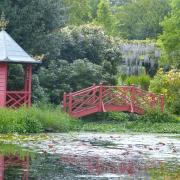Rivers of spring blossom and flowers flow alongside the sinuous curves of the river Stour. Arching above shimmering daffodils and narcissi, trees froth with blossom.
This is the wilder part of the garden, and particularly splendid in spring – but head gardener Stephen Moore said it is impossible to pick a favourite spot in the enchanting grounds of Great Thurlow Hall because highlights flow through the garden with the season.

First the snowdrops glitter through the woodland and then trees bud and blossom and thousands of spring bulbs appear. A line of apple trees along one side of the kitchen garden wall has been planted so that a wave of blossom flows across them and then they fruit in turn all the way through to November.
It is this attention to detail, this orchestration of nature, that makes the gardens at Great Thurlow Hall, near Haverhill, so impressive.
The borders in the walled garden have also been planted to blaze into a glorious profusion of early summer colour, with roses, peonies and irises processing down the border painting the space red, pink, purple and blue.
Once there were two gardeners just for the walled garden, keeping the hall supplied with fruit, vegetables and cut flowers. Now there are two gardeners for the entire 13 acres, Stephen who is in his 20th year here, and Melvyn Harris. who began as a teenager, 45 years ago.

The structure of the garden was designed by the grandfather of current owner, George Vestey, but there is constant change too as plants grow, mature and die, and gardening tastes and styles change.
The big new feature this year is a parterre, created where a disused tennis court once stood. The low yew borders, made up of 1,300 separate plants, are already thickening up, with Portugese laurel planted in the centre of each octagonal bed, ready to be trimmed into cone shapes and under-planted with cream and white flowers.
Colour and shape are supremely important throughout the gardens, which are designed in linked sections, joined by paths through high hedges, mown walkways, a flight of stone steps or bridges across the water. All year round there is somewhere with a fabulous piece of garden theatre happening. When the daffodils have dimmed beside the river the cow parsley takes over.

‘Cow parsley has probably always been here but people are gardening more for wildlife now,’ said Stephen. ‘They used it weed it out and now it’s become a feature in May and it’s a shame when it’s gone. But as that area fades, the borders take over.’
A sheltered lawn between the river and the house is planted with red, blue and purple borders. A venerable wisteria shimmers into purple splendour against a house wall in May, then there is the rose and lavender garden, an exuberance of summer colour, the harvesting of fine fruit and veg.
In the winter the structure of the garden becomes prominent, tall close-clipped yew hedges, the bare branches of stately trees and statement sculptures.
The owners, and particularly George’s wife, Nicola, are very involved in deciding on new designs and planting schemes and for most of the year these are private gardens.
But just occasionally, and on three days this year, the grand garden gates of Great Thurlow Hall are thrown open to visitors.

The gardens have been opening to raise money for the nursing and health charities supported by the National Garden Scheme for a magnificent 67 years. This spring they showed off woodland glades sparkling with snowdrops and are open again on April 7, when the daffodils along the river walk and the spring blossom trees, including cherries, apples, plums and pears, should be their most glorious, and on June 2 for its early summer glories.
By June the focus has moved to the walled garden and its walkway through parallel beds of peonies, irises and roses, the colours deepening from pale pink to purple and then red, travelling away from the house. ‘They really do look spectacular,’ said Stephen. ‘When people come in June they are blown away by the borders.’
People come for the plants and design, the landscape, the village setting, between river, church and farm, and, of course, the home-made teas. Some simply soak up the atmosphere, others are expert gardeners themselves and keen to ask Stephen about particular specimens and techniques.
He loves his job and enjoys the open days. ‘It’s really nice to share the garden occasionally. The open days give us a little bit of a focus, we aim to time things for them,’ he said. ‘And we always get asked how we manage, just the two of us.’
He began gardening as a child, growing up in Yorkshire, where his dad was a miner and a keen gardener. When his dad moved his veg plot to an allotment, Stephen, aged 15, took over the space to grow flowers, including roses, a cutting garden and hanging baskets.

‘I didn’t think about doing anything else as a job,’ he said. He worked his way up to becoming head gardener at the National Trust’s renowned Coughton Court in Warwickshire, before moving to Great Thurlow Hall.
‘I love it. It’s a privilege to be in a place like this,’ he said.
Throughout his gardening career he has particularly loved roses but now he thinks his absolute favourite aspect of gardening is growing his own vegetables. ‘I don’t think there’s anything more satisfying than growing produce and putting it on your table,’ he said.
And is there anything he is not so keen on? ‘There aren’t too many jobs I dislike but the thing I dislike most about gardening is we are starting to get these hotter and hotter summers. You can wrap up against cold or wet weather, so it’s not the cold or the wet, but the heat I don’t like.’
When he is not tending the grand gardens of Great Thurlow Hall he has his own village garden to look after, and he and his wife also love visiting gardens. ‘I especially like the gardens at Holkham, Houghton and Felbrigg in Norfolk, Helmingham in Suffolk and the Beth Chatto garden in Essex,’ he said.
The gardens of Great Thurlow Hall, Great Thurlow, near Haverhill, will be open in aid of the National Garden Scheme on Sunday April 7, 2-5pm. Admission £5 for adults, children free. Homemade teas will be available and the neighbouring Curwen Print Study Centre, Art Studios and Gallery, featuring work by leading 20th century printmakers, will also be open to garden visitors, with artists demonstrating printmaking.
Great Thurlow Hall gardens will also be open for the National Garden Scheme on Sunday 2 June.
Other Suffolk gardens opening for the National Garden Scheme charities in April include:
Porters Lodge, Cavenham, near Bury St Edmunds, with its fountains, follies and a water organ playing music by Haydn. Monday April 1, 10am-4pm, £5, children free.
The Place for Plants, East Bergholt Place Garden and Arboretum, Sundays April 7 and 28, 2-5pm.
Sunday 28th Blakenham Woodland Garden, Little Blakenham near Ipswich. Sunday April 28, 10am-4pm. £5.
For full information on the Suffolk gardens opening for the National Garden Scheme in 2024, pick up the latest brochure from garden centres and tourist information centres or visit ngs.org.uk
3 more Suffolk gardens to enjoy in April
Ickworth House gardens. The earliest Italianate gardens in the country are open every day, 10am-4.30pm, with an Easter trail through the parkland until April 14.
Fuller’s Mill Garden, West Stow, near Bury St Edmunds, open on Wednesdays, 2-5pm and Fridays, Saturdays and Sundays, 11am-5pm, from April 3. The enchanting seven-acre garden on the banks of the River Lark was created over 50 years.
Somerleyton Gardens, near Lowestoft, are some of the finest in the county. Restored and reimagined as a series of ‘rooms’ they include a grand parterre, walled garden, rose garden, sunken white garden, arboretum and one of the finest yew mazes in Britain. Open Tuesdays, Thursdays, Sundays and Bank Holiday Mondays.




























